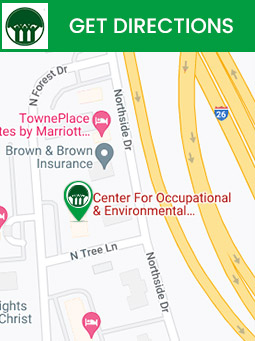Yeast-Yet Again! (An Interview with Dr. Lieberman, MD Founder/Retired)
Visit The Center for Occupational and Environmental Medicine (COEM) today to get specialized care. For more information, contact us today or schedule an appointment online. We are conveniently located at 7510 North Forest Drive North Charleston, SC 29420.


Table of Contents:
YEAST-YET AGAIN!
Q: What has made this field of yeast-related illness so timely for several decades now?
Q: What was Shaw’s background and why did he get interested in this himself?
Q: In what way does a bowel dysbiosis or yeast overgrowth actually manifest? How does that impact upon the brain?
Q: And that might show up as autism, or hyper-activity, or other neurologic problems?
Q: So he has seen a reversal in the problems of the patients who have been treated on the basis of his Organic Acids Urine Test?
Q: And you’ve seen a change in the behavior of those you’ve treated, too?
Q: Does dysbiosis or yeast overgrowth cause other problems besides changes in behavior?
Q: And if you don’t find the metabolites of yeast, is that the end of it?
Q: What other conditions would mimic those symptoms that a patient would think were caused by yeast?
Q: What would be the treatment for yeast overgrowth, and is there any rule of thumb about how long treatment should be continued?
Q: Many patients seem happy to take anti-fungal medications, even expensive ones, but less inclined to follow diet changes. In your experience, what effect do anti-fungal medications without dietary changes have on the patient’s progress?
Q: What happens when a person tries to diagnose himself or herself with yeast overgrowth and tries to self-treat? Can that be beneficial or harmful?
Q: So testing for these organisms is key?
An Interview with Dr. Lieberman (Founder/Retired)
Editor’s Note: Many times we on the staff have heard a patient say, “Oh, I wish I could have sat with Dr. Lieberman (Founder/Retired) for hours-I learned so much!” In this “chair-side chat,” Dr. Lieberman (Founder/Retired) explores the connection between yeast and developmental delays, food allergies, asthma, and even prostatitis.
Dr. Lieberman (Founder/Retired): When I first started working in this field in the late 1970’s, I thought every patient had yeast, and I treated everybody accordingly. After awhile I got disillusioned and I said, “No, this is impossible, nobody has it!” As the years went by, the pendulum swung back again. If you’re an astute clinician and you talk to patients, you see that yeast is a problem.
The paper presented by Dr. William Shaw at one of the American Academy of Environmental Medicine conferences in Kansas City was the real bombshell, because it gave us, for the first time, really hard evidence that many physicians were right who talked about yeast as a major cause of impairments.
Dr. Lieberman (Founder/Retired): Dr. Shaw, as an analytical biochemist, was analyzing the urine of two brothers. He didn’t know anything about these children, except that once the results came from the laboratory, he had never seen the presence of these particular metabolites before. He said, “These are not normal metabolites of normal people,” and ultimately realized that they were metabolites of bacteria and fungi. When he inquired about the children he had tested, he found that they both were autistic. So then he started to look at the urine of other children with autism and other neurologic problems, and lo and behold, he found that their urine also contained the same metabolites. That was really the great breakthrough-the presence of yeast and abnormal bacteria produce identifiable chemicals in the urine.
With Shaw’s paper, we now had a scientific basis to show, beyond a shadow of a doubt, that a patient can have these organisms and be influenced by their metabolites of them.
Dr. Lieberman (Founder/Retired): To me, the most amazing thing is to look at levels of yeast metabolites in the urine of children who have been on antibiotics for their ear infections. We wonder what happens to these kids-why their behavior changes and why they develop all kinds of problems-and there it is. Shaw’s contribution has been not only to identify yeast metabolites as a cause of neurologic problems, but also to show an imbalance in the gut bacteria can produce abnormal metabolites. The imbalance of the gut flora is called dysbiosis.
Dr. Lieberman (Founder/Retired): Small molecules have the capacity to go through the blood-brain barrier and it seems that they are amazingly capable of altering cerebral function. We know, for example, that in digesting and metabolizing wheat and other grains containing gluten, certain types of opioids can be produced and these things can really affect brain function. Well, now we see that organic acid molecules that are coming from yeast and bacteria are also capable of crossing the blood-brain barrier and influencing behavior and brain function.
Dr. Lieberman (Founder/Retired): When I’ve talked with Dr. Shaw, he said he’s seeing a lot more of these organic acid metabolites in the urine of hyper-active children. That doesn’t surprise me in the least. There is an epidemic of these problems in children. They’re sick all the time and why are they sick all the time? It is because of their diet, food sensitivities, and the development of secondary dysbiosis problems with either yeast or bacteria that produce these metabolites. The metabolites are actually causing behavior problems.
Dr. Lieberman (Founder/Retired): When Dr. Shaw found these unusual metabolites in the urine of the brothers, he asked the parents, “Why don’t we put these children on some anti-fungal drug and see what happens?”
With anti-fungal treatment, the yeast metabolites in the children’s urine decreased and their behavior improved.
So we have a very wonderful cause and effect relationship. Of course, it takes more than treatment of yeast to clear all behavior problems, but this can be a critical piece in the treatment program.
Dr. Lieberman (Founder/Retired): Yes, definitely. As you read our Testimonials from successfully treated patients or their parents, you see that treatment of yeast has made a huge difference in behavior in many cases.
Dr. Lieberman (Founder/Retired): Dysbiosis is actually an imbalance of all the microbiological flora of the gut, not just a yeast overgrowth. Dysbiosis produces a permeability dysfunction so that things that should remain in the G.I. tract are now getting through the wall in bigger pieces. Bigger pieces are more antigenic, meaning they are capable of producing an immunologic response, especially an allergic response. That’s how we think the mechanism of food sensitivity is being created. The more antigens from a permeable gut enter the circulation, the more immune response would be initiated. A permeable gut, which can be caused by dysbiosis, does make the problem of food allergy much worse.
In addition, once the antigen enters the circulatory system, it’s carried to all the organs of the body and comes into contact with those elements of the immune system called lymphocytes. If the antigen triggers lymphocytes and immune response in the lung, it might set off asthma. If the antigen triggers an immune response from the lymphocytes in the Peyer’s Patches of the G.I. tract, it might trigger diarrhea. It usually takes a combination of insults for the organ to react, so that is why we say in Environmental Medicine, “The previously injured organ becomes the target of the allergic response.”
Depending upon a person’s family history and medical history, any organ might be the target and produce adverse symptoms.
But what is important here for our discussion is that if yeast is a root cause of gut permeability or food allergy or other symptoms, we can confirm the presence of the yeast through Shaw’s test for the metabolites of yeast and bacteria. Now we don’t have to be defensive in trying to present this whole yeast connection concept to the scientific community.
If the metabolites of yeast are not there on testing, then we have to rethink the whole thing. I would like to address this for a minute. We all see these patients who come into the office who are totally convinced that all their problems are coming from yeast. They have literally put themselves through a mangle-there isn’t any anti-fungal drug that they haven’t been on, there’s nothing that they haven’t tried, and they feel that they’re still full of yeast. In many ways, we now have some nice criteria to say with confidence to a patient, “There is a problem, but it’s not yeast, and we have to look elsewhere. Trying to do only yeast eradication cannot be the total answer to the problem you have.”
Dr. Lieberman (Founder/Retired): That’s an interesting question, because when you’re a medical student and you’re taking the course called “Medicine,” you’ve got this textbook that has almost 2,000 pages. You say, “Okay, what are the signs and symptoms of this disease and that disease?” You find they’re often the same!
That is what makes Environmental Medicine so unique, because we’re not interested in choosing an organ and just identifying the signs and the symptoms.
The only thing that makes any difference is what causes those signs and symptoms, and what you’re going to find is that there are many ways to produce headache and the flu-like symptoms in a patient. They can come from anything from A to Z, usually a combination of things. But one of those causes is often Yeast. It doesn’t matter if yeast is affecting the nervous system, the G.I. system, or the joints. If yeast is a cause and you treat it, it’s astounding the myriad of signs and symptoms that can respond in that patient.
Dr. Lieberman (Founder/Retired): In our practice, we’ve always used a rather classical approach with systemic anti-fungal drugs and local-acting fungal drugs, often combined. With this approach we can treat the reservoir of yeast in the gut with the local-acting fungal drugs, but also treat elsewhere in the body where yeast may have been able to migrate due to a permeable gut or impaired immune system that didn’t keep the yeast localized. It depends upon the patient as to how long the treatment has to be applied.
For example, interestingly, many cases of chronic prostatitis in males are actually yeast prostatitis, and that’s the reason why they never get rid of the problem because they’re treated with more and more antibiotics. It’s often a combination infection of both yeast and bacteria, and until you identify which organisms are causing the infection and treat them appropriately for a sufficiently long time, the problem doesn’t resolve. We have not found cultures and stool analyses and other diagnostic tests to be entirely accurate, but with the aid of the other newer tests we use like Shaw’s test, we have very good results with many different kinds of chronic problems.
Dr. Lieberman (Founder/Retired): Well, I can answer that question because I was remiss when I first started working with these kinds of patients. I felt the diet was not the most important thing and what we needed to do was just use the drugs. What I found was that it didn’t work too well and especially there was a rebound effect after the drugs were discontinued. If you want to really try to hold these organisms down, it’s so important to stop feeding them with so many different kinds of sugars, even so-called natural sugars that are concentrated into syrups and such, and with refined carbohydrates.
Dr. Lieberman (Founder/Retired): The question that you asked is really very relevant. Most patients will read the wonderful books by Billy Crook [William Crook M.D., who wrote the whole Yeast Connection series of books] and think, “That’s what I have!” But as I said before, if you study medicine you find that many diseases have common signs and symptoms.
I have given patients credit for being more knowledgeable than the doctor in terms of better knowing their bodies, but we gave an example before of some patients whose whole life was obsessed with the idea that they were overrun with yeast. We were able to document with these new biomarkers that it wasn’t yeast at all.
So what they did in a sense was just waste time, probably money, and effort. They were looking at the wrong cause, and that’s why they never got better. It probably takes a combination of a physician plus a patient, because the physician has to develop a more comprehensive approach and write a prescription, if necessary. Nevertheless, doctors don’t give patients enough credit for understanding their own problems, so here at our Center we try very much to respect patients when they come tell us their histories.
We have to look for the root causes of a patient’s many signs and symptoms, and a patient can’t do that on their own very often. It takes the sophistication of testing and identifying biomarkers, and with those laboratory findings, we can do a much better job of diagnosing now.
Dr. Lieberman (Founder/Retired): Well, actually the most helpful testing involves looking for causes in many areas, not just hidden infection.
One other common element that needs to be thought about is the combination of allergy and hidden infection.
I’ll give you an analogy, and maybe then you can appreciate it. There was a woman who was my patient who pointed her finger at me and said, “If I touch a drop of wheat, within two hours I have a rip-roaring yeast infection. Explain that, Doctor!” The lesson that’s learned from this, of course, is that there are triggers for each individual that increase susceptibility to infection. So when necessary we also test for food, inhalant, pollen, or chemical allergies in our patients. With our allergy desensitization extracts, and also avoidance of the most severe triggers in some cases, it’s not only easier to treat hidden infections but a lasting resolution is possible. Then too, we try to build patients up through nutritional supplementation or whatever else is needed in their particular case to make the patient stronger to resist infections.
We come back to our philosophy here at The Center for Occupational and Environmental Medicine (COEM) that you don’t just get sick, you’re made sick, and we do our best to identify what is making you sick and help you to get well again. We serve patients from Charleston SC, Mount Pleasant SC, Summerville SC, North Charleston SC, Goose Creek SC, Ladson SC, Hanahan SC, James Island SC, John’s Island SC, Daniel Island SC, West Ashley SC, Moncks Corner SC, Sullivans Island SC, Folly Beach SC, Isle of Palms SC and all of South Carolina, Nationally, and Internationally. Patients routinely fly into Charleston to be evaluated by COEM and to enjoy this beautiful city, which is a Condé Nast and Travel and Leisure Top Domestic and International Tourist Destination.










